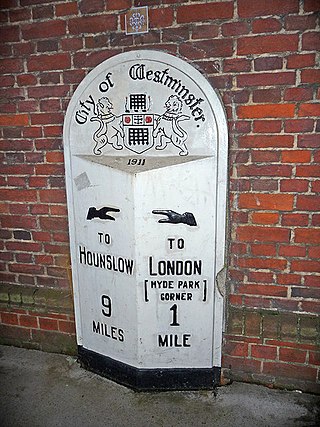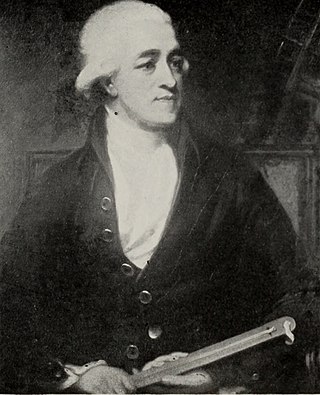Related Research Articles

The mile, sometimes the international mile or statute mile to distinguish it from other miles, is a British imperial unit and United States customary unit of distance; both are based on the older English unit of length equal to 5,280 English feet, or 1,760 yards. The statute mile was standardised between the British Commonwealth and the United States by an international agreement in 1959, when it was formally redefined with respect to SI units as exactly 1,609.344 metres.

The yard is an English unit of length in both the British imperial and US customary systems of measurement equalling 3 feet or 36 inches. Since 1959 it has been by international agreement standardized as exactly 0.9144 meter. A distance of 1,760 yards is equal to 1 mile.

A grain is a unit of measurement of mass, and in the troy weight, avoirdupois, and apothecaries' systems, equal to exactly 64.79891 milligrams. It is nominally based upon the mass of a single ideal seed of a cereal. From the Bronze Age into the Renaissance, the average masses of wheat and barley grains were part of the legal definitions of units of mass. Expressions such as "thirty-two grains of wheat, taken from the middle of the ear" appear to have been ritualistic formulas, essentially the premodern equivalent of legal boilerplate. Another source states that it was defined such that 252.458 units would balance 1 cubic inch (16 cm3) of distilled water at an ambient air-water pressure and temperature of 30 inches of mercury (100 kPa) and 62 °F (17 °C) respectively. Another book states that Captain Henry Kater, of the British Standards Commission, arrived at this value experimentally.

A pennyweight (dwt) is a unit of mass equal to 24 grains, 1⁄20 of a troy ounce, 1⁄240 of a troy pound, approximately 0.054857 avoirdupois ounce and exactly 1.55517384 grams. It is abbreviated dwt, d standing for denarius –, and later used as the symbol of an old British penny.

A faggot, in the meaning of "bundle", is an archaic English unit applied to bundles of certain items. Alternate spellings in Early Modern English include fagate, faget, fagett, faggott, fagot, fagatt, fagott, ffagott, and faggat. A similar term is found in other languages.
The long hundred, also known as the great hundred or twelfty, is the number 120 that was referred to as hund,hund-teontig,hundrað, hundrath, or hundred in Germanic languages prior to the 15th century, and is now known as one hundred twenty, or six score. The number was translated into Latin in Germanic-speaking countries as centum, but the qualifier long is now added because English now uses hundred exclusively to refer to the number of five score (100) instead.

The digit or finger is an ancient and obsolete non-SI unit of measurement of length. It was originally based on the breadth of a human finger. It was a fundamental unit of length in the Ancient Egyptian, Mesopotamian, Hebrew, Ancient Greek and Roman systems of measurement.

A finger is any of several units of measurement that are approximately the width of an adult human finger, including:
A nail, as a unit of cloth measurement, is generally a sixteenth of a yard or 21⁄4 inches (5.715 cm). The nail was apparently named after the practice of hammering brass nails into the counter at shops where cloth was sold. On the other hand, R D Connor, in The weights and measures of England states that the nail was the 16th part of a Roman foot, i.e., digitus or finger, although he provides no reference to support this. Zupko's A dictionary of weights and measures for the British Isles states that the nail was originally the distance from the thumbnail to the joint at the base of the thumb, or alternately, from the end of the middle finger to the second joint.
English units are the units of measurement used in England up to 1826, which evolved as a combination of the Anglo-Saxon and Roman systems of units. Various standards have applied to English units at different times, in different places, and for different applications.

The ancient Roman units of measurement were primarily founded on the Hellenic system, which in turn was influenced by the Egyptian system and the Mesopotamian system. The Roman units were comparatively consistent and well documented.

Sir George Augustus William Shuckburgh-Evelyn, 6th Baronet was a British politician, mathematician and astronomer.
Various measures of paper quantity have been and are in use. Although there are no S.I. units such as quires and bales, there are ISO and DIN standards for the ream. Expressions used here include U.S. Customary Units.
Winchester measure is a set of legal standards of volume instituted in the late 15th century (1495) by King Henry VII of England and in use, with some modifications, until the present day. It consists of the Winchester bushel and its dependent quantities, the peck, (dry) gallon and (dry) quart. They would later become known as the Winchester Standards, named because the examples were kept in the city of Winchester.
Capacities of wine casks were formerly measured and standardised according to a specific system of English units. The various units were historically defined in terms of the wine gallon so varied according to the definition of the gallon until the adoption of the Queen Anne wine gallon in 1707. In the United Kingdom and its colonies the units were redefined with the introduction of the imperial system whilst the Queen Anne wine gallon was adopted as the standard US liquid gallon.
Kenneth Meyer Setton was an American historian and an expert on the history of medieval Europe, particularly the Crusades.

The siege of Paris of 845 was the culmination of a Viking invasion of West Francia. The Viking forces were led by a Norse chieftain named "Reginherus", or Ragnar, who tentatively has been identified with the legendary saga character Ragnar Lodbrok. Reginherus's fleet of 120 Viking ships, carrying thousands of warriors, entered the Seine in March and sailed up the river.
Historical metrology is the science that is dealing with the fundamental units of measurement, systems of units formerly in use in various countries, and the development of monetary units throughout their history.
Approximate measures are units of volumetric measurement which are not defined by a government or government-sanctioned organization, or which were previously defined and are now repealed, yet which remain in use.

Jan Gyllenbok is a Swedish author and expert on historical metrology with an academic background in engineering and computer science. He is known for his encyclopedia on historical systems of measurement units.
References
- ↑ See also: Historical metrology
- ↑ "Ronald Edward Zupko." Contemporary Authors Online. Detroit: Gale, 2007. Gale Biography In Context. Web. 16 Nov. 2011.
- ↑ Contemporary Authors . Vol. 13. Gale Research. 1984. ISBN 0-8103-1942-X.